I was the Forage Scout yesterday. What that entails is getting my 56 year old rear end fastened to a dirt bike for a rough and tumble journey of 140 miles across hill and dale and mountain and canyon and seeing what the grassland situation is across all of our wilderness range. There’s some old logging, hunting and elk trails scattered across the high country that accommodate a dirt bike fairly well. I’d rather be horseback, any day and every day, but the ride I had to do covered way too many miles and vertical elevation change for a horse (I went up and down over nearly 15,000 feet of vertical elevation). Indeed, as Mr. Frost penned, I had miles to go before I would sleep. And I had promises to keep—to the crew and cattle.
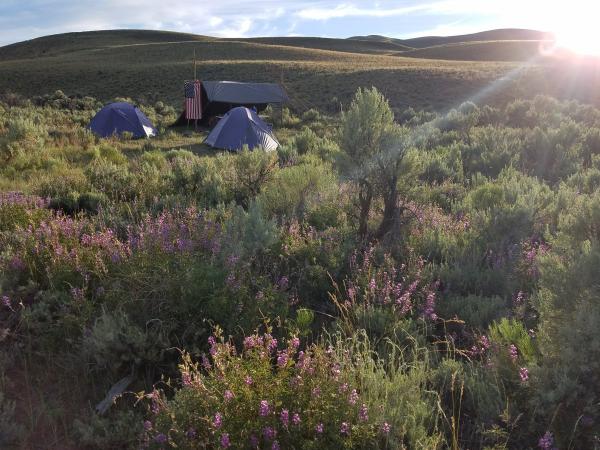
My first stop at mid-morning was to find the crew and the beeves so I could touch base with them. They too had many miles to cover that day as they were moving up about 1500 feet in elevation and closer to the timbered lands of the high forests. They would stop and graze the herd for a few days in Bear Basin, a perched and rolling high tableland that marked the transition from sagebrush studded grassland to that pocketed with Douglas-fir evergreen forests and aspen.
I found them pasted to the steep north face of Big Deer Mountain, taking a break from the near unrelenting climb skyward. The beeves seemed content, laying down and quietly chewing cud or absentmindedly grazing, and just resting. The crew consisted of cowhands Melanie (trailboss), Jeremiah, and Linnaea. They were off their mounts, grabbing some early lunch and water. Although it was a bright sunny day, the elevation and the incessant mountain breeze made it comfortable. The border pups passed out in the shade of steeds.
I walked through the cattle quietly. They had been around all of us enough now, living with the crew 24/7, that they didn’t get up from their siesta as I checked them out.
“How’s Ol’ Snakebite doing?” I threw the question to the wind for whoever would answer.
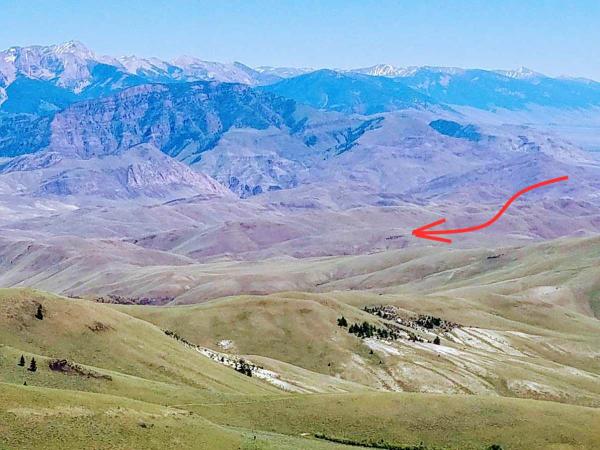
Linnaea caught it. “Oh, he’s OK. The swelling is going down, and he’s breathing well. He’s grazing like the rest of them.”
Jeremiah waved his hand to the rear of the sun-basking herd. “He’s in that bunch somewhere. I think he’s OK.”
A few days ago, the abundant rattlesnake population had taken its toll on the grazing herd, and one fanged the yearling steer’s noggin. Right on the cheek it landed, and within a half a day, the poor guy was packing a volleyball sized venom reaction on the side of his face. It looked a little unwieldy, but cows have an amazing ability to compartmentalize injury.
The guy just kept right on eating, even with that volleyball. It would have killed a human.
I got on dirt bike and rode on. I had the weight of several NO SPRAY signs in my heavy backpack, and needed to replace the ones that vandals ripped off from spots along our 55 miles of pasture boundary fence during last fall’s hunting season. We need to declare organic to ensure that county weed crews on foot or ATV don’t willy nilly spray chemical toxicants on our range.
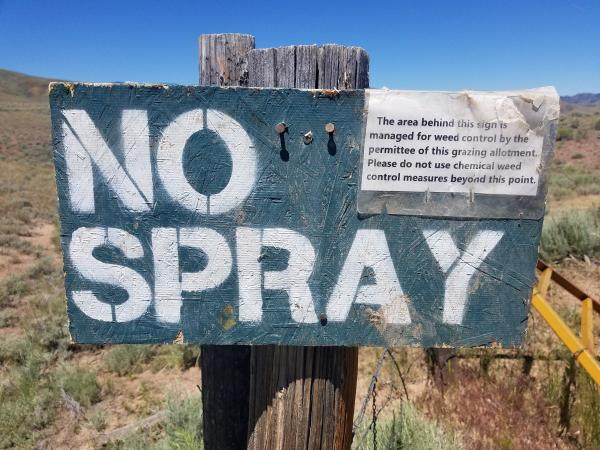 Â Then, there was the intentional rubbing of the word “NO” off the signs that were still there. And missing from all of them was the little sub-sign that told why we don’t spray. They were just ripped off and gone.
 Then, there was the intentional rubbing of the word “NO” off the signs that were still there. And missing from all of them was the little sub-sign that told why we don’t spray. They were just ripped off and gone.
I told Linnaea about my sign replacement mission, and about the vandalism. Someone had gone through a lot of work with a knife to carve the “NO” off.
“Are you serious? Who the heck would do that? What is their problem?” Her usually happy face read incensed consternation.
“I have no idea. I don’t even get it.” I responded. And I didn’t. I mean, what do they care if we’re organic?
“Maybe they feel threatened or something by us. But I can’t even identify with that.”
Maybe it’s that we’re against the status quo, and anyone doing that is a threat. I really don’t know. But I do know the sign stuff is clearly intentional. Often we’ll find the missing signs stashed under a bush nearby. Weird. Who knew that we’d have to keep making signs?
I slung my faded and tattered Lowe Expedition pack over my shoulder. In my younger days, back in the seventies and eighties, I backpacked all over the Rockies of Canada and the Northern US with it. It was a state of the art backpack and climbing pack at that time. Now, it just carried hardware, fencing tools, signs, a hammer and lunch. I kicked the old Suzuki DR over, and puttered up the road, with still over 100 miles ahead.
It was a multipurpose venture into the wilds of the upper ranges. I was doing forage inventory for sure, but I was to plan our next 4 camps, the water strategy, and the grazing around those areas. The scout has to be a combination of a grazing expert, water systems engineer (watering 300 head on a hot day where they’ll drink 20 gallons each can be a challenge), camp planner (need comfort for human and graze for their horse) and a predator interaction prevent-er.
For the last, I plan a human camp right next to where the cattle bed down (wolves prefer not to hang with humanity) and contrive placement of a solar powered electric fence to keep the bears out. Our model states that no-one on either side needs to die, and we proactively plan on how to keep interactions from happening.
Then, it was weed inventory on 60 square miles. Spring time is in full swing at 7000 to 9000 feet in these remote mountains. A little trace of last winter’s snow still decorates the high ridges, and that means that soil moisture is at peak to match the long days of June. Weeds are also at their peak this time of year, and a hate relationship to these invaders makes everyone on Alderspring’s team extremely acute at picking weeds out of our otherwise intact native flora. And killing them.
Intact native flora is the centerpiece of our grazing range. There are up to 1500 native plants here in 10 plant community types. It is one of the few places on the planet (literally) that maintains plant and animal populations on it nearly as they have appeared for millennia. And intact communities growing above the soil surface means intact soil communities below. The soil biome is alive and well on the Hat Creek range.
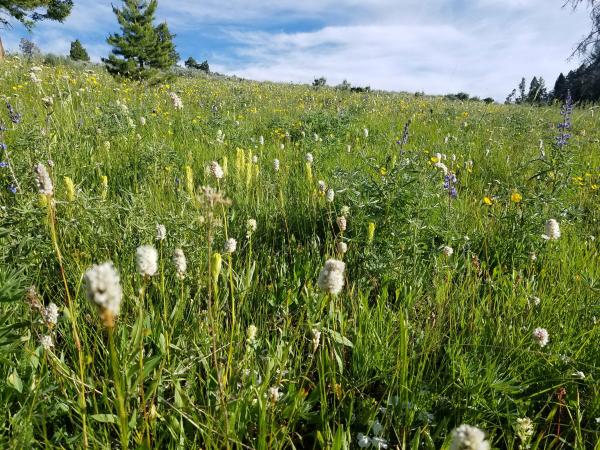
And that complex animal and plant web is critically important to me, a purveyor of wild protein. We tested some steaks this week from our first spring harvest off of wild grass, and we perceived the flavor a notch up from our regular great beef: it was of a deeply profiled satisfying intensity. That means nutrient and mineral content found in native plants and soils. And when non-native species mess with the delicate balance of wild, resentment and a desire for redemption join in the minds of our team to make wrongs right.
Here’s what right looks like: I’m cruising along on an old log road and get whacked by fragrance that makes me inhale deep draughts like craft brew from a schooner. I drop the bike in neutral, and roll to a stop (I often freewheel down the long hills with the engine off so I can hear birds and the other animals we share this country with. There was many elk with young calves on their sides I came upon in the quiet of the coasting bike).
It is the wavy leaved Ceanothus that emits the fragrance. I step off the trail, and wade into the dense hip deep shrubbery of them, abloom with a carpet of white at the tops. I am intoxicated with the sweet scent. But clearly, others are too. Many species of native bees are at it, in drunken joy with the larder they found. The buzzed excitement of them makes me more than a little cautious at cutting a few stems of flowers for my pack. I needed to bring some of the scent home for Caryl and the girls.
Upon scanning the nectar harvesters, no honeybees are found among them, which is not surprising at all. Given the fact that they were introduced to North America (likely by the Puritans in the 1600s) and the remoteness of the Hat Creek Ranges, they simply aren’t here, and never have been. But surprisingly intact are the many natives buzzing in the Ceanothus stems.
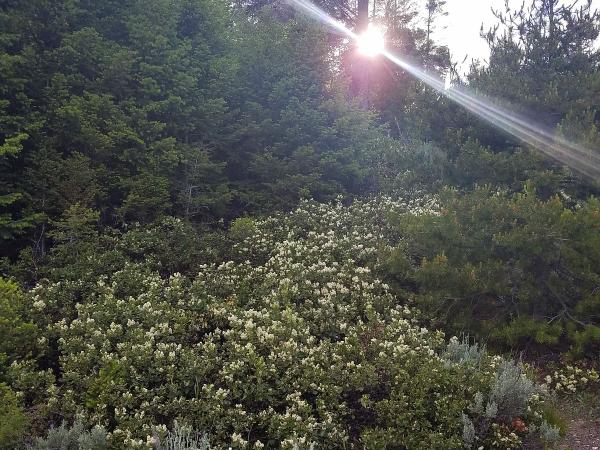
I think back to the heartland of the Midwest’s corn belt where I was last week, an area with broad ubiquitous use of agricultural chemicals, and how many people at the conference I was attending lamented the loss of bees—of all insects. Thankfully the chemical culture hasn’t and won’t arrive in Hat Creek anytime soon. It is safe because of its de-facto remoteness, and the organic practices that we steward it with.
Back to the 100 mile journey: my next stop was to drop dinner off at my high altitude weed crew. They were four stalwart and hardy young souls employed by a contract forest work crew broker: the Montana Conservation Corps. There’s Todd, crew boss from Connecticut; Halle and Karlissa from Montana; and Cody from Florida. I have them camped at a week at a time where the native trout-occupied main stem of Hat Creek tumbles over granite boulders beneath the shadowy groves of great Englemann Spruce forests along the North Boundary of the Hat Creek Range.
Their job: search and destroy insurgent plants without any ecosystem-web destroying chemicals. They expertly wield grub hoe and shovel and hard pulling gloved hand, and are armed with knowledge and GPS locators that document any weed population they discover. They also take years of data from map and GPS datasets to relocate any historically documented weed strongholds.
Todd asks me how long I will go back to check on the existence of those previously found strongholds. “Forever, Todd. As long as I live and work up here.” Latent seed or living roots can stay hardy for years, dormant, deep in the soil. Then, they suddenly express. And we need to be there waiting to catch them emerge and keep flowering and seed production from happening. Pull, kill and destroy. No chemicals. Ecosystem biota intact.
I explained the importance of organic to them, and how although there are always people who malign organic certification, this was the real deal. We are passionate about maintaining the native health of these landscapes, not only for the likes of bees, but equally importantly. because of the connection with our own wellness. In essence, I see our partners, you readers, as part of our ecosystem. It’s because you live off the fruits of a healthy biota up there. And that is a holistic view that gets us out of bed every morning; there is such rightness to what we do in that connectivity.
I dump tired Lowe Expedition on the ground, and unroll my slicker after pulling it out, uncovering the frozen goods. “I bring gifts. Organic fruit of this very land.” It’s our beef—some of our nice fatty ground and a package of our Chorizo sausage. The crew lights up and gushes gratitude.
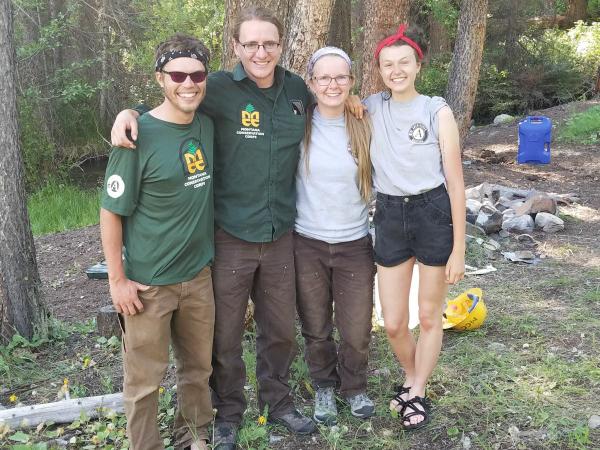
Then I tell them the sad news: I can’t stay around to cook it. The sun was going down, and I still needed to find my cowhand crew in Bear Basin before nightfall, about 35 trail miles away. “I’m sorry.” I smile at them in the spruce filtered light. “Josh is simply more awesome than I am.”
Josh, one of our main Alderspring hands and a veteran of nearly 4 years, journeyed the many dirt bike miles up there last week and brought the weed crew dinner. He got a little fire going and cooked burgers on a little grate he brought in the oncoming dusk. Their weed-war worn bodies embraced the wood-fired goodness, gratefully. They were a little blown away, it seemed. But Josh really gets that it is all-important to connect the produce of our wild landscape with people. We make sure that everyone that works here gets to eat our beef, the fruit, so to speak, of their labor.
But equally important, it is critical for you, our partners to connect flavor with that of a wild, high functioning native ecosystem. It’s one of the few such places left intact on Earth.
Happy Trails
“‹”‹”‹”‹”‹”‹”‹Glenn, Caryl, Cowboys, and Cowgirls at Alderspring Ranch

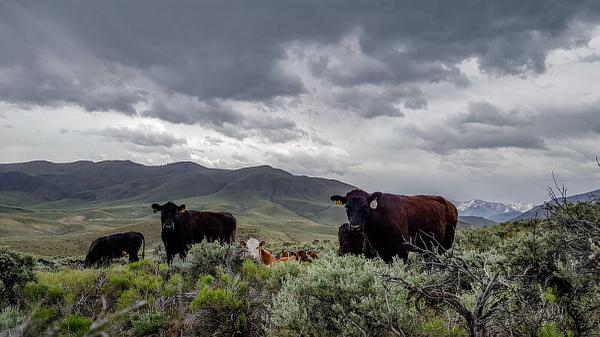
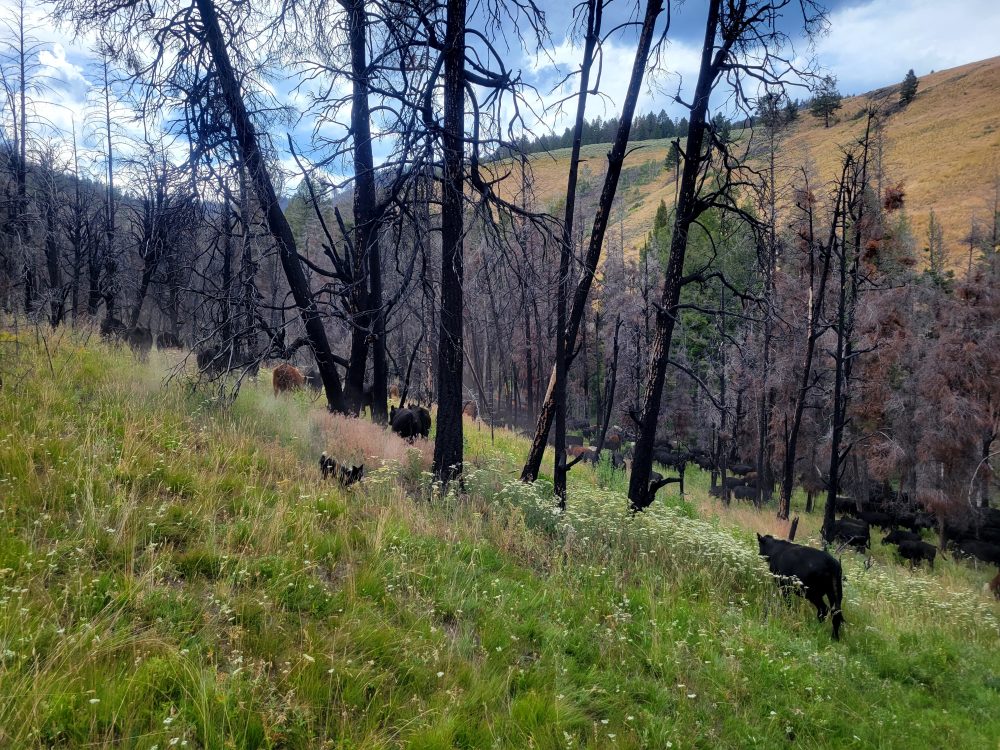

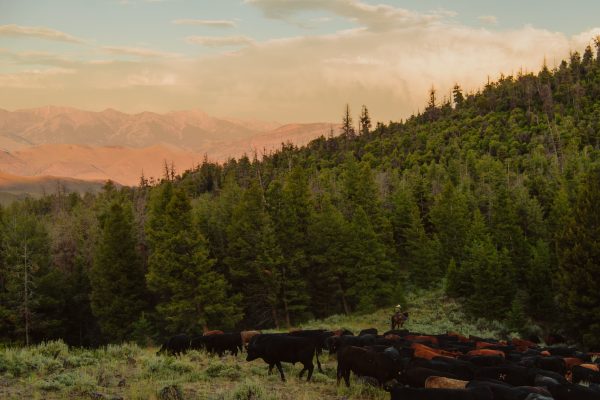
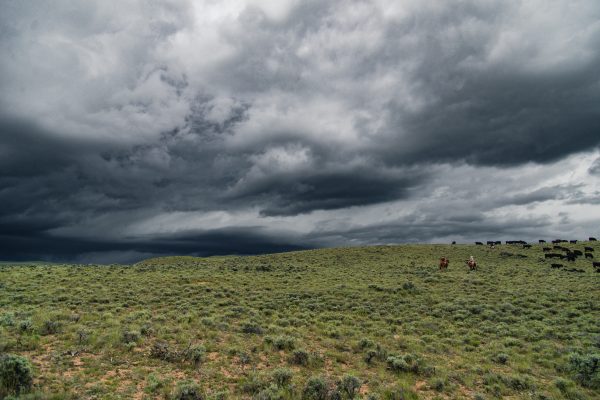
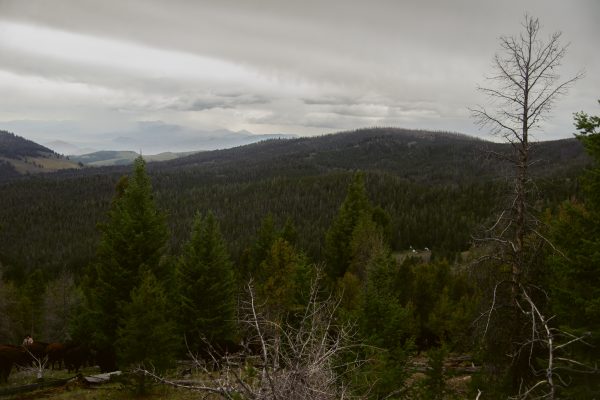
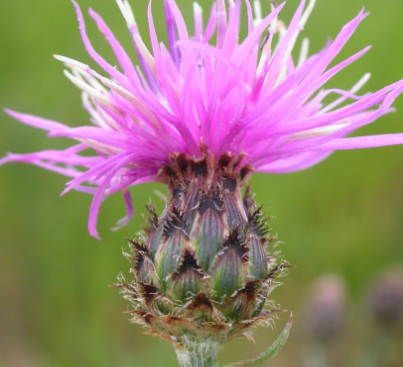
Leave a Reply